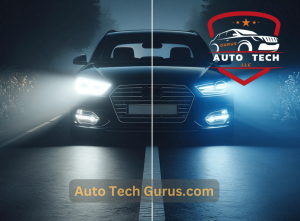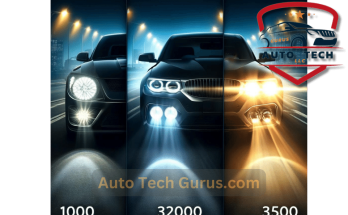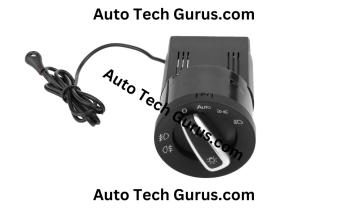If you’ve ever driven at night, you’ve probably noticed some vehicles with distinctive blue headlights. They stand out, but you might wonder, “Are blue headlights legal?” Today, we’re diving into the legality of blue headlights, how they compare to standard headlights, and what makes them so popular among car enthusiasts.
What are Blue Headlights?
Blue headlights, or blue headlight bulbs, emit a bluish tint compared to traditional white headlights. They fall into a category known as blue LED headlights, which include various types of bulbs like blue LED lights for headlights, blue LED headlight bulbs, and even blue car headlights. These bulbs are often sought after for their aesthetic appeal and strong resemblance to the lighting on luxury vehicles.
Legality of Blue Headlights
When we talk about the legality of these lights, the question arises: “Is it legal to have blue headlights?” The simple answer is that it varies. The lawfulness of blue-coloured headlights, including blue and blue headlamp bulbs, depends heavily on local laws and regulations. In some regions, any hint of blue in headlights is prohibited due to the potential for confusion with emergency vehicles, which typically use blue lights. Therefore, in many places, are blue headlights illegal? Yes, they are.
Blue Headlights vs White Headlights

Compared to blue headlights and white headlights, each has pros and cons. Blue LED headlights can provide a modern, high-tech look, but they might not offer the same level of visibility and safety as white headlights. White headlights are the standard because they are typically more transparent and effective at illuminating the road ahead.
Why Do People Choose Blue Headlights?
So, what is the purpose of blue headlights? Many drivers opt for blue light headlights or bluish headlights for aesthetic reasons. They’re a popular choice among younger drivers and car enthusiasts who want to give their ride a unique or upscale look. The appeal often lies in standing out from the crowd and mimicking the blue headlights of cars seen on more expensive luxury models.
Considerations Before Installing Blue Headlights
Before jumping on the bandwagon and installing blue-colored headlight bulbs, asking, “Can you have blue headlights?” in your area is crucial. Ensuring that your blue headlights are legal in your jurisdiction is critical to avoiding fines or being required to remove them.
Furthermore, while blue headlights look cool, their functionality should be your top priority. Visibility and safety on the road should always come first.
Whether you’re thinking about upgrading to blue LED headlight bulbs or you’re simply curious about what those blue headlights are called, it’s important to do your homework.
Understanding both the aesthetic and practical implications of blue vs. white headlights can help you make an informed decision that combines style with safety.
Remember, while blue headlights can enhance your car’s appearance, ensuring they are legal and effective is crucial for your driving experience.
Here’s an overview of the laws regulating the use of headlights in the USA, Canada, Australia, and the UK. These regulations help ensure vehicles have proper lighting for safe driving, especially at night and in adverse weather conditions.
USA
In the United States, headlight regulations are set by the Department of Transportation (DOT). The fundamental rules include:
- Colour: Headlights must emit a white or amber light. Any blue tint is prohibited.
- Brightness: Headlights must be bright enough to provide substantial visibility but not so bright as to blind other drivers. There are specific regulations concerning the luminous intensity and range.
- Automatic Headlights: Some states require headlights from sunset to sunrise and in poor visibility conditions such as fog or heavy rain.
- High Beams: Drivers must dim high beams when approaching another vehicle within 500 feet or following a car within 300 feet.
Canada
Headlight laws in Canada are similar to those in the USA, regulated provincially, and tend to follow these general guidelines:
- Color: Headlights must be white or yellow. Lights emitting blue tints are illegal.
- Usage: In Canada, the legal time for headlights to turn on begins half an hour before sunset and lasts until half an hour after sunrise. Additionally, due to severe weather conditions in Canada, it is necessary to turn on the headlights if visibility is less than 150 meters.
- Daytime Running Lights (DRL): All vehicles manufactured after December 1, 1989, must be equipped with daytime running lights.
- Aiming: Headlights must be properly aimed to avoid dazzling other road users, with requirements for regular maintenance and alignment checks.
Australia
In Australia, vehicle lighting is governed by the Australian Design Rules (ADR):
- Color: Headlights must emit a white light. The use of blue or other coloured lights is illegal.
- High Beam and Low Beam: Drivers must use low beams within 200 meters of an oncoming vehicle and follow another vehicle within 200 meters.
- DRLs: Not mandatory, but they must comply with ADR specifications where fitted.
- Fog Lights: Fog lights may be used only in fog, rain, or dust conditions and must be switched off when visibility improves.
UK
In the United Kingdom, vehicle lighting regulations are detailed in the Road Vehicles Lighting Regulations 1989:
- Color: Here, headlights are only meant to emit white or yellow light. Blue light-emitting headlights are only allowed to be installed on emergency-vehicles.
- Usage: Headlights must be used between sunset and sunrise and when visibility is seriously reduced—generally when you cannot see for more than 100 meters (328 feet).
- High Beams: High beams must not be used in built-up areas or where they may dazzle other road users.
- Headlight Aim: Headlights must be appropriately adjusted to prevent dazzling other drivers, requiring them to be checked during the vehicle’s MOT (Ministry of Transport Test ).
While the specifics can vary slightly between countries, the overarching goal of these regulations is to promote safety by ensuring all vehicles have effective and appropriately used lighting. Always check local laws if you’re unsure about compliance in your area or if you plan modifications to your vehicle’s lighting system.
Conclusion
In this blog, we learned where blue headlights are legal and where they are illegal. Blue lights come in various types, and if they are legal, the specific type allowed varies by jurisdiction. We also discovered the correct timing for turning on headlights and compared blue and white headlights to determine which was better. Some individuals use them for recreational purposes. Finally, it is concluded that using headlights emitting yellow light is always better.



